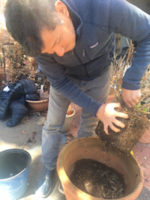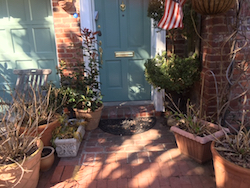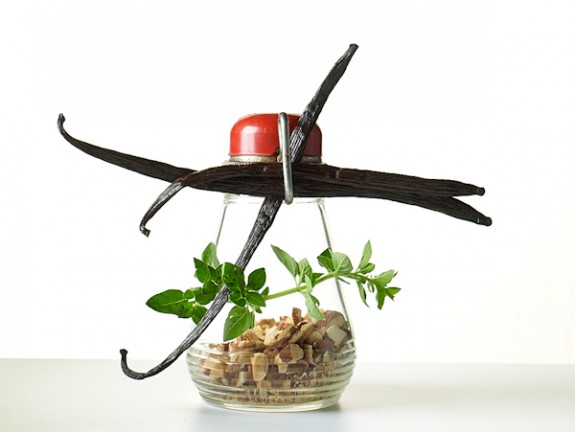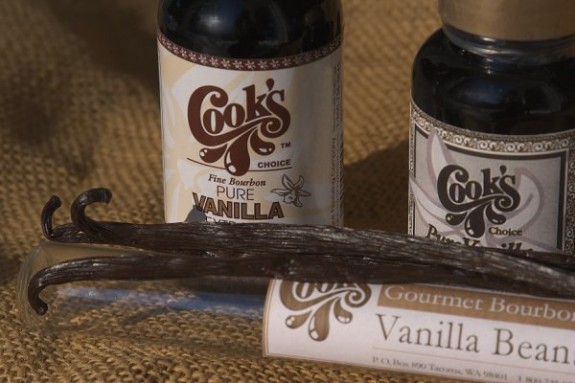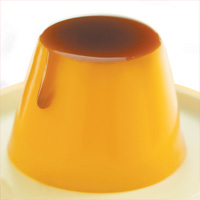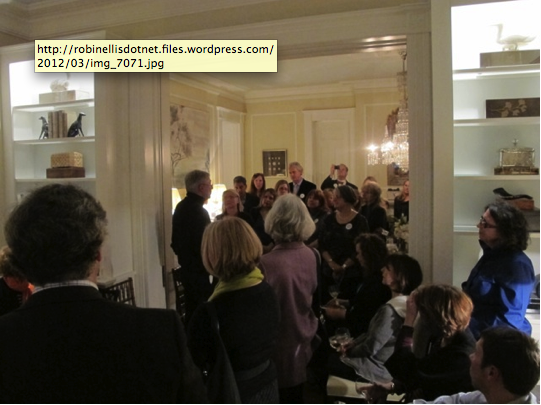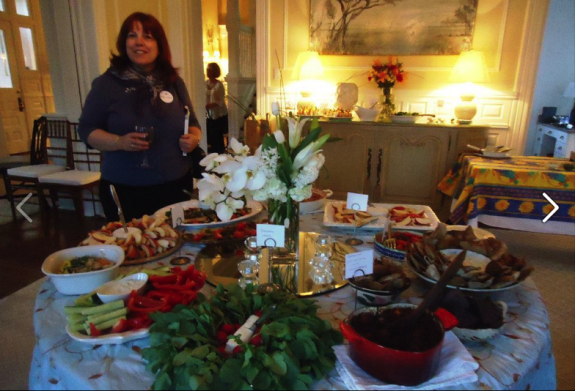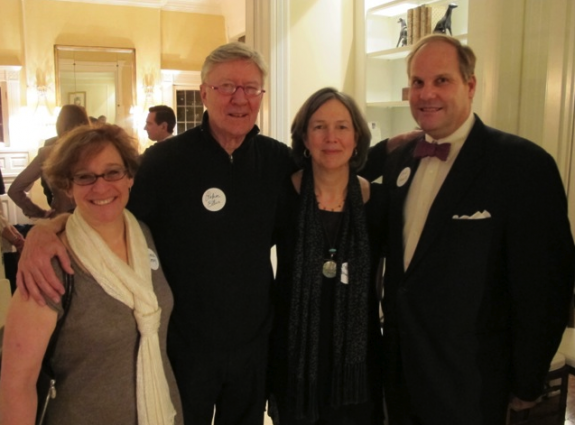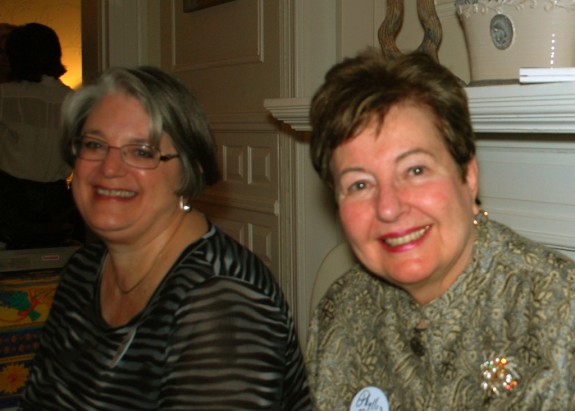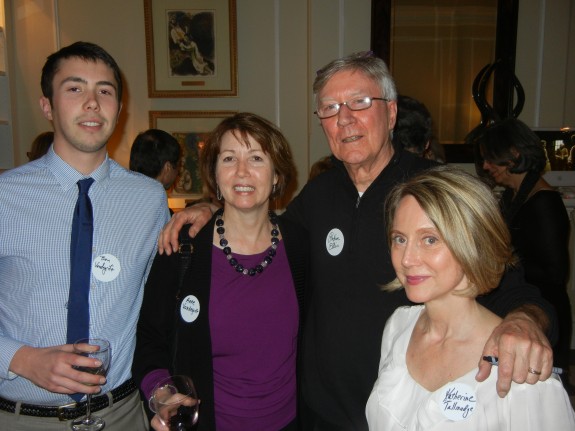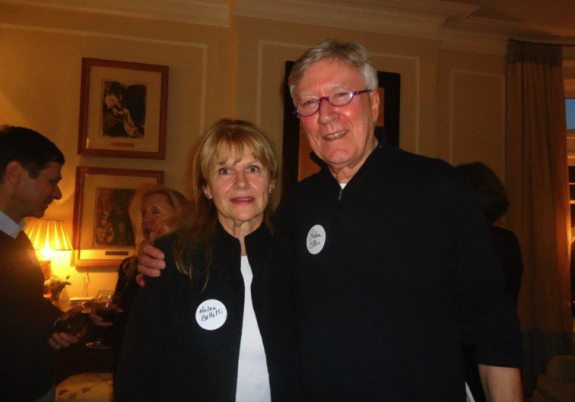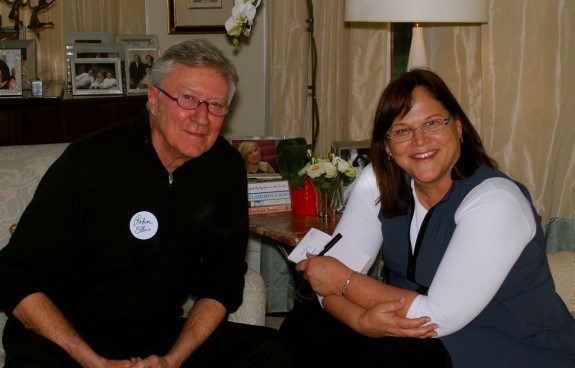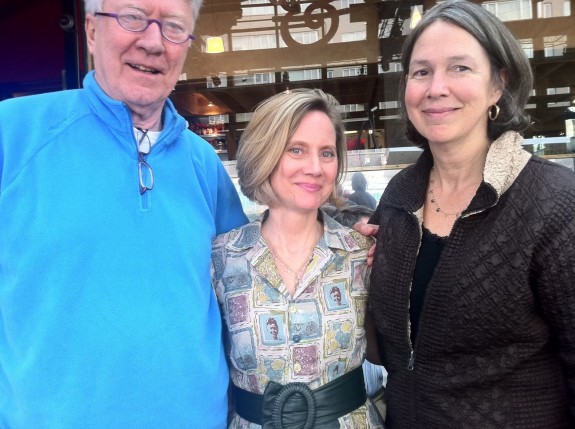Meditation on the Beauty of Autumn and Our Ancient Ginkgo Trees
- At November 04, 2018
- By Katherine
- In Articles, News
 0
0

Ginkgo Trees Exhibiting Their Gorgeous Halo of Saffron-Yellow on the Streets of Washington, DC. This particular stand of Ginkgos is in Rose Park in Georgetown, DC’s East Village (photo by Judith Beerman)
Getting out in nature, among trees, in the fresh air, and even a little sun, is essential to your health, according to medical experts. Luckily, here in Washington, DC, there are still wild forests and waterways to enjoy close by and in every direction, but luckily right in the middle of the city, too.
Song for Autumn
by Mary Oliver from New and Selected Poems: Volume II (Beacon press)
In the deep fall
don’t you imagine the leaves think how
comfortable it will be to touch
the earth instead of the
nothingness of air and the endless
freshets of wind? And don’t you think
the trees themselves, especially those with mossy,
warm caves, begin to think
of the birds that will come — six, a dozen — to sleep
inside their bodies? And don’t you hear
the goldenrod whispering goodbye,
the everlasting being crowned with the first
tuffets of snow? The pond
vanishes, and the white field over which
the fox runs so quickly brings out
its blue shadows. And the wind pumps its
bellows. And at evening especially,
the piled firewood shifts a little,
longing to be on its way.
There is a controversy raging about a particular prolific city tree and whether to chop them down. Ginkgo trees are all over DC, on several blocks in Georgetown, a neighborhood here, and have been for at least 40 to 50 years, and some, for over 100, even perhaps 150 years or longer. “The 27th Street stand of Ginkgos in the East Village of Georgetown are the largest and oldest in the United States, according to National Arboretum staff,” said long-time Georgetown resident Nancy Flinn. Some neighbors don’t want them, at least not the female Ginkgos, because at a certain time of the year, they can be pretty messy and smelly. But not everyone agrees with the proposed solution of eliminating the trees. It’s a hot debate in a community, such as Georgetown, which values its trees and historic preservation.

“They’re glorious trees! They shouldn’t cut them down; it’s the reason I live here!” said Georgetown resident and world traveler, Lloyd Thorson, who believes the tree in front of his building, Downing and Vaux, on 30th Street, “must be at least 300 years old.”

Some experts date the tree back to at least the 1840s. Ginkgos grow very slowly, so getting to such a large size indicates it is quite old, probably at least 150 years old. Here, the Ginkgo next to Mr. Thorson, in a closer up photo, shows the wide girth of this ancient specimen.
“There are amazing Ginkgos on the U.S. Capitol grounds, including one near the Supreme Court that dates back to Frederick Law Olmsted’s landscaping [Olmsted designed NYC’s Central Park],” said Melanie Choukas-Bradley, author of The Joy of Forest Bathing: Reconnect with Wild Places & Rejuvenate Your Life, and other nature books, who leads nature walks sponsored by the Smithsonian Associates and the Audubon Naturalist Society. “Behind the Smithsonian castle … there are some beautiful Ginkgos,” Ms. Choukas-Bradley said.

They’s such an old plant species, Ginkgos are considered “living fossils,” dating back 270 million years, first appearing in the early Jurassic period.
“What a fabulous tradition to have in our historic village,” said Outerbridge Horsey, noted architiect and Georgetown neighbor, referring to the the Ginkgos’ provenance. Mr. Horsey is a co-founder of “Trees For Georgetown,” dedicated to “plant and maintain the trees that line the residential streets of our community.” Trees For Georgetown along with Casey Trees and the DC Urban Forestry Division, nowadays, only plant male Ginkgos, such as the “Princeton Sentry” in Georgetown, according to Mr. Horsey.

Ginkgo leaves are uniquely fan-shaped and prized for their beauty.
Ginkgo trees are either male or female. The females develop 1/2 to 3/4 inch seeds with a soft yellow-brown outer layer and a hard shell on the inside. The nut-like shells in the center of the seed are prized in Asia as a delicacy. You’ll often see Asian cooks gathering the Ginkgo seeds on DC sidewalks! To some Georgetowners, though, female Ginkgo seeds, once they drop and get crushed – often on sidewalks – are thought of as a smelly nuisance during the month their berries drop (about November/December). And herein lies the controversy: What to do about those stinkin’ berries?
The people who want to replace the old-growth, large, old female Ginkgo trees with young male trees say the fallen berries are slippery and dangerous, and the smell is noxious (not many would disagree with that assessment!). One neighbor lamented that the berries might affect the real estate value of his home if he needed to sell during the month that the berries have dropped.

Others are passionate about saving the Ginkgo Trees. They say Georgetown’s Ginkgos are historic, “old growth,” huge, beautiful, and provide much needed shade. New Ginkgos would take decades to match the size of the ones they’d be standing alongside in Georgetown. Besides, trees are naturally messy, all have their drawbacks and need maintenance: Slippery leaves… sticky pollen… dirty berries that stain… dangerous branches… nasty bird droppings… Is the only fix to chop down all the trees?
None of the solutions seem perfect. Sweeping or hosing down the Ginkgo berries off the sidewalks works, but only if everyone would cooperate and do their share. One neighbor said, “Little would be the task of most residents along 27th Street [where many Ginkgo trees live] to simply sweep the pods out of harm’s way now and again during the Fall season. Could those residents enjoy the pleasures of being out and about to conduct such sweeping? … [Together] with nearby neighbors? … Trash collectors could perhaps play a role as well.”
In years past, the District sprayed the Ginkgos annually to prevent the trees from reproducing and developing berries in the first place. But the spraying hasn’t been done consistently, and since the Ginkgos have to be sprayed at a specific time in their reproductive cycle, if it’s raining, the spray may not be effective. Perhaps the spraying could be made more effective if the DC government cooperates, and possibly sprayed twice, said one resident.
The Georgetown East Village neighbors who want to cut down their female Ginkgos were given permission to do the deed. But so much community angst has erupted over the possibility of losing these majestic trees, the decision has been put off until the Advisory Neighborhood Commission’s December 3rd meeting, when there will be a discussion and a vote by the entire ANC, the non-partisan neighborhood body made up of locally elected representatives known as Advisory Neighborhood Commissioners. The ANC must “support” removal for it to take place. Previous to that meeting, “there will be public notice and the opportunity to comment,” said Jim Wilcox, the ANC 2E06 Commissioner, who represents the neighborhood in Geogetown’s East Village in which this heated argument about chopping down the Ginkgo trees is on-going.
Katherine’s Weekly Market Recipe: Light Sweet Potato Flan with Vanilla Bean
- At November 06, 2012
- By Katherine
- In News, Recipes
 0
0
My very luscious version of a “flan,” a custard dessert, is lighter and simpler than most, and highlights one of the most nutritious seasonal foods – the sweet potato, and a favorite flavor: Vanilla. The vanilla’s quality is essential to the flavor, so I buy special plump, juicy California vanilla beans – the kind top chefs use – from Cook’s.** Sprinkle the flan with toasted pecans for a bit of crunch. Make in six or eight “personal” soufflé dishes, or in one large dish. Perfect as a holiday dessert!
Today is the 12th “Katherine’s Market Recipe,” all of which are designed to be delicious, easy, quick, family-friendly, nutritious (heart-healthy & diabetes-friendly), and to highlight produce found at our local Farmers Markets this week. At your Farmers Market, you’ll find produce picked at peak ripeness, which means maximum flavor, texture and nutrition. You’re also helping save the environment when you buy at your Farmers Market. Here’s how…
For my “Light Sweet Potato Flan with Vanilla Bean,” I recommend you buy your sweet potato at the Glover Park – Burleith Farmers Market on Saturday, or Dupont Circle’s Fresh Farm Market (open year-round) on Sunday.
**Cook’s Vanilla
And don’t forget the Cook’s Vanilla for your Flan and other holiday baking. I first discovered this special vanilla in Georgetown’s Griffin Market (now closed). It peaked my interest because former Washington Post food reporter (and longtime Georgetown resident), Walter Nicholls, endorsed it and provided it to Griffin. Apparently, Walter has teamed up with Paso Robles, California’s Cook Flavoring Company, a family-owned business. “They personally monitor the cultivation and harvest of its vanilla beans in a way that few can match and no one can exceed, extracting the flavor by the same slow, cold extraction method the family has been using for almost a century,” said Walter. The best pastry chefs in town seem to use it: Baked & Wired, Dolcezza, Black Salt, CoCo Sala, CityZen, the Hay Adams hotel and all of Jose Andres restaurants, to name a few. Beans and extract are available locally at Rodman’s on Wisconsin Avenue.
Katherine’s Light Sweet Potato Flan with Vanilla Bean
Serves 6 – 8
2 Cups 1% Lowfat Milk
2/3 cup Granulated Sugar
½ Vanilla Bean, halved lengthwise
¾ pound Sweet Potato (1 large)
2 Eggs
1 Egg Yolk
1Tablespoon Warm Molasses (Optional)
1 ounce (1/4 cup) Chopped, Toasted Pecans or any favorite Nut (Optional)
Preheat oven to 350 degrees F. Place sweet potato on the oven rack and let cook for about 45 to 60 minutes or until tender when pierced with a fork. Use long tongs to pull out of the oven. When warm to the touch, remove the peel. Mash the potato flesh and measure out ¾ cup.
Turn oven temperature down to 325 degrees F. Lightly butter or spray the insides of 6 or 8 ½-cup ramekins* or a 6-cup glass Pyrex bowl or soufflé dish.
In a medium saucepan, bring milk, sugar, and vanilla bean slowly to a boil, stirring until sugar is dissolved. Turn off the heat. Pull out the vanilla bean and scrape the vanilla seeds into the milk mixture. Return the pod to the pot and let sit for 15 minutes to let flavors blend.
Meanwhile, puree the 2 eggs and 1 egg yolk with the mashed sweet potato (I use a Cuisinart Smart Stick immersion hand blender). Add the sweet potato mixture to the warm milk mixture and puree until well blended – most easily done (and less messy) with an immersion hand blender. For a smooth custard, try not to create too many bubbles.
Pour the liquid into six or eight ramekins, or into the 6-cup soufflé dish. Set the soufflé dish(es) into a large baking pan and add boiling water until it is halfway up the sides of the soufflé dish(es). Place in the center of the oven and bake until slightly wobbly in the middle – about 40 to 45 minutes for the individual ramekins or 1 hour if you’re using the larger soufflé dish.
To serve: Leave the custards in the water bath until they are not too hot to handle or until ready to serve. Slide a knife around the inside edge of the individual dishes and turn them onto serving plates. Or scoop out 6 or 8 servings from the large soufflé dish. Over each serving, drizzle the warm molasses and sprinkle chopped, toasted pecans.
**A “ramekin” is an oven-proof ceramic or glass serving dish, usually round, but sometimes in novelty shapes, ie, hearts or ovals.
The entire recipe = 1,000 calories (1,242 calories with molasses and pecans). Divided into 6 servings = 167 calories per serving (207 with molasses and pecans). Eight servings = 125 calories per serving (155 with molasses and pecans).
Katherine’s “Light Sweet Potato Flan with Vanilla Bean” was adapted from award-winning cookbook author, Deborah Madison’s “Local Flavors: Cooking and Eating From America’s Farmers’ Markets.”
Sweet Potatoes, considered one of the “Super Foods,” are loaded with Beta-Carotene, the orange pigment which is a potent anti-oxidant. It is important for your immune system, your skin, your vision, bones, reproduction, and may reduce cancer risk. But sweet potatoes provide so much more; they’re also high in fiber, vitamins C, E, the B vitamins, and minerals such as potassium, manganese, magnesium and iron. Sweet potatoes’ origins date back thousands of years in Peru, became a favorite of Christopher Columbus once he landed in America, and grow particularly well in the American South, where they have become a staple.
Robin ‘Poldark’ Ellis Charms Washington, D.C. and Me
- At March 09, 2012
- By Katherine
- In Articles, News
 3
3
It’s official. Now that I’ve met Robin Ellis in person during his recent Washington, D.C. visit, I have gone completely gaga over this talented and elegant actor, chef, and author, and his warm and lovely collaborator and wife, Meredith Wheeler. But I’m also charmed by his cookbook, website, and blog. I believe you will agree, and feel transported… inspired… to live a better, healthier life.
When I heard Robin Ellis was coming to D.C. to promote his new Mediterranean cookbook, I jumped into action, and so did a group of generous, community-minded people who came together to give Ellis and Wheeler a warm Washington, D.C. welcome. Washington Fine Properties’ Nancy Taylor Bubes opened her home and her heart to more than 80 guests, the American Institute of Wine and Food co-sponsored, Bistrot Le Zinc Executive Chef, Janis McLean, demonstrated one of Ellis’s signature recipes, and at least twenty guests and fans brought dishes from Ellis’s book.
Ellis is known worldwide as the swashbuckling Captain Ross Poldark, the lead character in the classic BBC Masterpiece Theater series, “Poldark,” originally aired in the 1970s, but recently hailed as “a cure for your ‘Downton Abbey’ blues,” by Los Angeles Times media critic, Robert Lloyd, after viewing the series for the first time. I agree with Mr. Lloyd: but expect a LOT more action, excitement, and ribaldry!
The Washington Post’s food writer, Bonnie Benwick (also an avid admirer) said “Over 29 episodes, social and political intrigue ensue, with heaving bosoms and rugged landscapes and a soaring musical score,” You can enjoy watching the original “Poldark,” on IMDB. It aired for the first time on Acorn TV, an excellent streaming website. It is run by a company where I, incidentally, conducted wellness programs (it’s a small world, isn’t it?). There is a new version, which Robin Ellis generously applauded, though I can’t bring myself to watch it, loving the original so much. Ellis has written a book about his experience, “Making Poldark: Memoir of a BBC/Masterpiece Theater Actor.”
For the past twenty years, Robin Ellis has lived in the south of France with his American wife, Meredith Wheeler, and their menagerie of animals, where he has collected and tested recipes while becoming an accomplished chef. I feel so fortunate he was willing to share his time, his talents, and his evocative stories and photos of his life in the south of France. His culinary experiences and travels, and even step-by-step recipe instructions, have been an inspiration.
Ellis was diagnosed with Type 2 Diabetes twelve years ago and has managed to keep the disease controlled, stay healthy, fit, and even optimistic. “After a few weeks of shock, and ‘why me,’ the diagnosis became an opportunity to get into shape,” said Ellis. “It opened up a whole new culinary path.” His new book, “Delicious Dishes for Diabetics: Eating Well with Type 2 Diabetes” (Skyhorse Publishing, 2011) is for anyone who loves Mediterranean classics. The Mediterranean diet is one I heartily endorse for anyone for superior health, but also, satisfying dining. I’ve witnessed the surprise, relief, and joy when my clients stabilize, and even reverse their Type 2 Diabetes. Robin Ellis did it and you can too!
See a few recipes and a beautiful video montage of Robin Ellis cooking in the south of France
Read The Washington Post’s story about my March 7 Robin Ellis event in Georgetown which contains details about Robin Ellis’ life and new cookbook
Read Robin’s own account of the Georgetown Event on his blog
Read about the Robin ‘Poldark’ Ellis cookbook reception in The Georgetown Dish
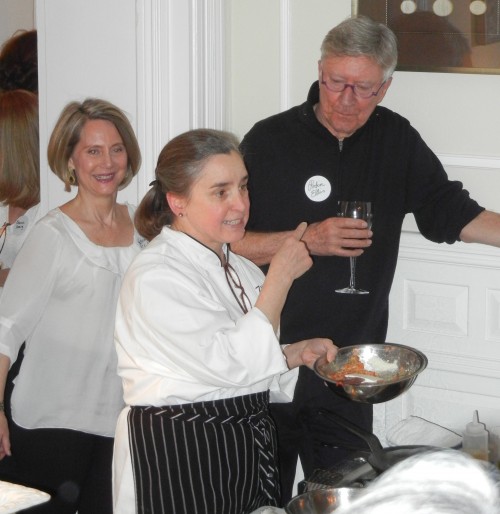
Janis McLean and Robin Ellis demonstrating “Salmon Fishcakes with a Sauce of Yogurt, Mustard and Dill”… Katherine “helping” in background. Photo by Robert Arnold

Friends/Volunteers Begin Preparations in the Kitchen. Katherine Tallmadge, Elizabeth Mautner, Zach Lipson, Johanna Medlin. Photo by Meredith Wheeler
Nancy Taylor Bubes’ dining table was brimming with simple yet sublime Mediterranean dishes “Roasted Eggplant Slices with a Walnut and Garlic Spread,” “Grilled Lamb Chops with Rosemary,” “Tzatziki,” “Fennel Salad with Parmesan Shavings,” “Minestrone,” “Grilled Strips of Duck Breast smothered in Walnut and Garlic Sauce,” “Rice and Spinach Torte,” “Tuna and White Bean Salad,” “Spinach Salad with Bacon and Avocado,” “Goat Cheeses served with Apple and Pear Slices,” and more…
Debbie Weil, Lisa Lambert, Hostess Nancy Taylor Bubes, Roxanne Fleming. Photo by Johanna Medlin
Michelle Molotsky, Robin & Meredith, and Robert Arnold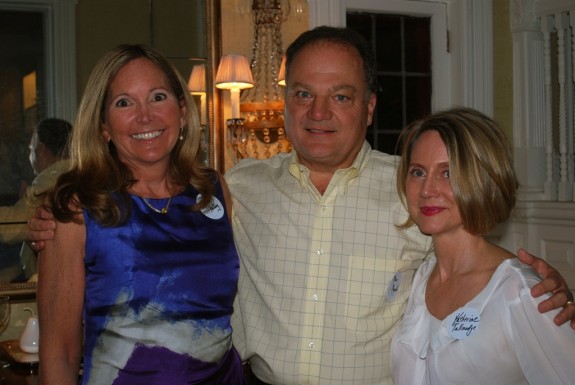
Katherine with Marcia Horting and Marc Marzullo
Helen Belletti and Robin Ellis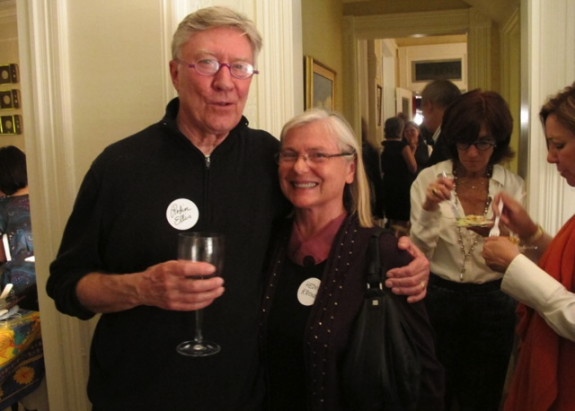
Robin Ellis with Hedvika Krone. Photo by Meredith Wheeler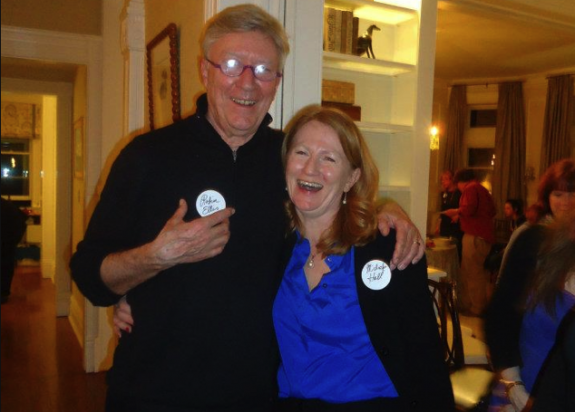
Robin Ellis and Michele Reilly Hall. Photo by Helen Belletti
Robin & Meredith surprised me with a lunch invitation at D.C.’s iconic “Kramerbooks & Afterwards” the day after… I feel truly blessed!
You Are Invited to a Cookbook-Signing Reception with Robin “Poldark” Ellis on March 7
- At February 28, 2012
- By Katherine
- In News
 3
3
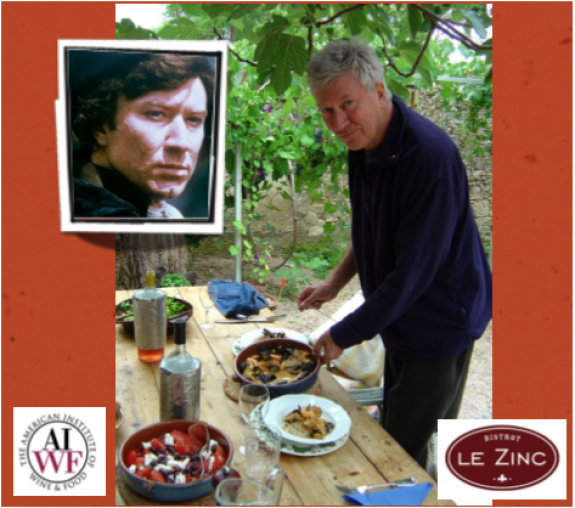
Please RSVP TODAY for the March 7 Robin Ellis book-signing and reception. Attendance is limited. See invitation and video montage below...
I have been completely charmed by actor, chef, and author Robin Ellis, his cookbook, website, and posts – and I believe you will be too. This is why I’m so pleased to ask you to join me, Nancy Taylor-Bubes, Robin Ellis, and his wife Meredith for a book-signing reception, celebrating the publishing of Ellis’s new Mediterranean cookbook. As you may know, the Mediterranean lifestyle and way of eating is one I heartily endorse!
Ellis is known worldwide as the swashbuckling Captain Ross Poldark, the lead character in the classic BBC series, “Poldark,” recently hailed as “a cure for your ‘Downton Abbey’ blues,” by Los Angeles Times media critic, Robert Lloyd, after viewing the series for the first time. I agree with Mr. Lloyd, only expect a LOT more action, excitement, and ribaldry! I’ve enjoyed watching the new DVD version of “Poldark,” available for the first time from Acorn Media, coincidentally a company close to my heart, as I have had the good fortune to conduct wellness programs with Acorn’s extraordinary staff (it’s a small world, isn’t it?).
For the past twenty years, Robin Ellis has lived in the south of France with his American wife, Meredith, and their menagerie of animals, where he has collected and tested recipes while becoming an accomplished chef. I feel so fortunate he is willing to share his time, his talents, and share a few stories about his life in the south of France with us. I hope you’ll join me, Nancy, the American Institute of Wine & Food, and Chef Janis McLean, in giving Robin and Meredith a warm American welcome!
YOU ARE INVITED
HOSTS: Nancy Taylor-Bubes and Katherine Tallmadge
CO-SPONSOR: The American Institute of Wine and Food
SPECIAL GUEST COOKING DEMONSTRATION BY: Executive Chef, Janis McLean, Bistrot Le Zinc
DATE & TIME: Wednesday, March 7, 2012; 6 – 8 pm
PLACE: Georgetown, Washington, D.C.
COST: $15.00 at the door, which provides you with a signed copy of Robin Ellis’s new cookbook
R.S.V.P. Katherine@KatherineTallmadge.com (and to receive more details)
DONATION: If you wish, you are invited to bring a dish from Robin Ellis’s cookbook or blog. When you send your RSVP, communicate your interest to bring a dish, and I will send you several recipes you could consider. You could also consider recipes on Robin’s website and the few examples on my website.
BOOKS: Provided by independently owned Bridge Street Books of Georgetown
SPACE IS LIMITED
Please RSVP no later than Tuesday, March 6
Michel Richard: Citronelle’s Master Chef
- At December 06, 2010
- By Katherine
- In Articles
 0
0
by Katherine E. Tallmadge
The Georgetowner
It’s a busy weekday afternoon in late November at Michel Richard’s Citronelle. The steady flow of customers is clearly warming the exuberant Richard’s heart. An assortment of elegantly dressed businessmen and women, tourists, and VIP’s stride through the restaurant and settle into tables where they prepare for an unforgettable dining experience.
From the moment you enter Citronelle, it is apparent that Michel Richard had a hand in the design. It is California fresh and bright, with accents of French glamour and a touch of Richard whimsy. The main dining area is covered in the warm, earth tones of Provence.
But the visitors come here less to bask in Citronelle’s decor — though beautiful it is — than to experience extraordinary cuisine that will be prepared by one of the nation’s — if not the world’s — great chefs and his staff.
In the enormous, glassed – in exhibition kitchen, Richard is presiding intensely over a plate, as several specialty chefs scurry back and forth with the dish’s various components. Like an artist with a palette, Richard takes an ingredient here, an ingredient there, places it just so, and voila! Each plate is an art piece worthy of a master. When it’s finally presented at the table, it’s difficult to disturb the arrangement. But worth it. Each deconstructionist bite carries a variety of textures and a symphony of flavors. This is not any ordinary culinary experience.
“I must give my customers the best,” says maestro Richard. “I want my customers to feel good, feel respected. I want them to feel like they’re coming to a second home, where they’re being taken care of by people who care.”
Richard (pronounced Ree-char) exudes perfection, attention to detail, and a need to please. His heart and talents seem boundless. He is widely regarded by his customers and colleagues as a genius.
“He’s D.C.’s new star,” says Francois Dionot, founder and director of the internationally respected French cooking school, L’Academie de Cuisine, in Bethesda.
“In my book, he has replaced Jean-Louis Palladin in Washington,” says Dionot, referring to Washington’s beloved and critically acclaimed chef formerly of Jean-Louis at the Watergate, who now has restaurants in Las Vegas and New York City.
Richard’s style is light, fresh and intelligent, focusing on innovative combinations, witty presentation and always an element of texture. Richard was a pioneer in creating the revolutionary French/California cuisine that is now so prevalent on the West Coast.
Richard says his life’s pivotal moment — when he knew he wanted to be a chef — occurred at the age of eight. He spent two weeks in the kitchen of a family friend’s restaurant. “The well-dressed ladies in the dining room, the white hats, aprons, and all the food — I fell it love with it,” he says.
But it was at age 14, when “God made me a chef,” he says. At fourteen, Richard apprenticed in a restaurant-run patisserie in Champagne, France. Three years later he moved to Paris when he quickly rose to the top position at Gaston Lenotre’s esteemed pastry shop.
But like many other chefs of his generation who came of age during the Paul Bocuse era, Richard wanted to move to America. The opportunity came in 1974 when Lenotre opened a pastry shop in the U.S. Unfortunately, America was not yet ready for Lenotre’s sophisticated French fare and the patisserie closed.
But Richard was not ready to move back to France. In 1975, he moved to Santa Fe to run a pastry shop serving simple meals. A year later he bought the shop and found the rewards of ownership creatively energizing and financially rewarding. But his talents were too large for Santa Fe.
“Santa Fe was not a dream for an ambitious young chef,” he says.
In 1977 he moved to Los Angeles and opened Michel Richard to instant success. He began traveling back and forth to France eating, learning, and cooking in three star Michelin-rated restaurants.
In 1987 Richard opened Citrus, adapting his native French cuisine to the tastes of Southern California. The critically acclaimed Citrus put Richard on the culinary map. In 1987, Traveler’s Magazine voted Citrus “The Best Restaurant in the United States,” and in 1988, Richard was inducted into the James Beard Foundation’s “Who’s Who in American Food and Wine.”
Next, Richard opened Citronelle in 1988 at an astonishing location in the Santa Barbara Inn Hotel overlooking the Pacific Ocean. But even this dream-like venue was not enough to quiet his ambitions.
Richard opened Citronelle in Georgetown in 1994 after years of attracting the glamorous and powerful to his West Coast restaurants. Four years after opening the D.C. restaurant, Richard decided to focus all of his efforts in Washington. So, in early 1998, Citronelle underwent a $2 million renovation and Richard moved from Los Angeles to Washington, D.C. to direct the kitchen full time. He now considers Georgetown his flagship restaurant.
Some may wonder why Richard chose Washington over New York City. For Richard, the answer is easy.
“I love the sophistication of Washington. It’s a piece of Europe — I feel like I’m in Paris — L’Enfant designed the town after all!” explains Richard. Though Richard says the move from Los Angeles was easy for him, his wife didn’t share those views and their marriage came to a crisis when she insisted they stay in Los Angeles.
“She complained I would work too many hours,” says Richard. But they both decided to throw themselves into Washington life and they moved their four children to the area. “We love each other too much,” says Richard.
Since opening Georgetown’s Citronelle, Richard has won more culinary awards. He was a nominee for the James Beard Chef of the Year Award for 1996. That same year he received the prestigious Five Star Fleur de Lis Award. Conde Nast Traveler magazine recently named Citronelle one of the “World’s Most Exciting Restaurants,” an honor shared by only 50 establishments worldwide, and only eight in the United States.
Richard travels the world in search of new ingredients and inspiration. He sleeps with a note pad by his bed because it’s not unusual for him to wake at 4 a.m. with a brilliant idea for a recipe. “Food is what I think about all the time,” he says. He considers himself a modern French chef, with access to ingredients from all over the world and a variety of cultures. “My pot is a melting pot of cultures and flavors,” he says.
But he can only be a great chef if he has superior ingredients, he says. And he makes the effort to find them because “it’s so fabulous every morning to get the ingredients– it makes me feel so good!”
“But it`s a fight,” he admits, as he describes the live scallops he buys at $5.00 a piece. Or the “unusually fragile and flavorful” Santa Barbara shrimp which must be flown out the same day they’re caught for him to use them the very next day. Richard wouldn’t consider using anything frozen. Everything must be fresh, seasonal and perfectly prepared. “The haricot verts aren’t cooked until they’re ordered!” he says.
His perfection is applied down to the smallest of details. Even the ground pepper is specially chosen for its sweetness (“sawak” from Indonesia) and ground at the last minute. He uses four different types of salt. And garlic is carefully roasted and sliced just before serving to prevent oxidation. Spices and herbs are roasted, ground and prepared in his kitchen “at the last second” for maximum flavor.
Richard uses unusual and exotic ingredients daily. Instead of lemon on his sauteed Santa Barbara Shrimp, he incorporated kumquat, because it is more “delicate” and gives him “more control” over the result. He uses $60.00 8-oz. bottles of olive oil, because it’s “the best oil in the world,” and one whiff of its fruity aroma tells you why.
Among top chefs, Richard is renowned as a genius with ingredients. He uses surprising combinations of textures — such as crunchiness and silkiness, and flavors — such as salty and sweet, with stunning results.
“Michelle started the trend for food having enormous contrast of texture,” says L’Academie de Cuisine’s Dionot. “His obsession with crunchiness and presentation are his trademarks.”
Richard’s training as a pastry chef gave him an appreciation for presentation. He’s one of the few chefs who started as a pastry chef. Pastry is more of a presentation than other courses and always has something crunchy with it. Most cooking never had those fine details, but Richard is one of the country’s innovators, says Dionot. “He made an impact and brought it to Washington.”
An astute businessman, Richard has plenty of ideas for improving his restaurant. He has designed a small sidewalk cafe for 30th Street that would be the new entrance to Citronelle as opposed to entering through the hotel lobby of the Latham Hotel on M Street.
“The neighborhood asked for a certain design and we think they’ll like what we came up with,” says a hopeful Richard. He admits they may not do much business outside, but he says it will be important for the restaurant’s “visibility.”
It’s ironic that a famous chef like Michel Richard would be concerned about curbside appeal but it is this attention to detail that makes Citronelle such an extraordinary restaurant, unmatched in its range and quality.
Katherine Tallmadge is a nutrition consultant, writer and speaker in Washington, D.C.
MICHEL RICHARD CITRONELLE: INNOVATING THROUGHOUT THE DAY
Washington received a new reason for a wake-up call recently when Michel Richard Citronelle began serving breakfast, making it one of the nation’s few five star restaurants to offer the morning meal.
As with everything else at Citronelle this is no blase affair. Richard has created some eye-opening dishes that include Lobster Hash with Tomato and Basil Hollandaise; a Chive Omelet with Smoked Salmon, Asparagus and Creme Fraiche and an extremely popular, non-fat Chicken Sausage.
Richard’s command of pastries makes for wonderfully delicate croissants as well as Toast d’Brioche and Pain aux Raisins et Pomme.
The same elegant service that the restaurant is known for at lunch and dinner is also standard for breakfast including the specially designed Bernardaud China and Christoffle Silver.
“Breakfast does not need to be boring,” says Richard. “It’s the most important meal of the day and I want my customers to enjoy their food as much in the morning as they do in the evening.”
Other recent innovations at Michel Richard Citronelle include the restaurant switching to fixed price options at dinner rather than a la carte. Guest are able to choose from three dinner menu ranging from $35 to $65 to $100 per person.
The change allows the restaurant to better showcase its range with more numerous courses and seasonally appropriate fare. Richard loves the fixed price approach because it lets the kitchen guide the patron through the day’s best work and prevents the temptation of intimidated diners from ordering a “green salad with dressing on the side.”
The really adventurous may want to consider an evening at the Chef’s Table where, for parties of six or more, Richard will dazzle you with specially prepared dishes in the midst of the hyper-activity of a world-class kitchen. The cost is $150 per person excluding wine but Richard guarantees he will prepare food to “your heart’s desire.”
And finally, the restaurant is open for the holidays including Christmas Eve, Christmas Day and New Year’s Eve. The special New Year’s Eve dinner is $200 per person. There can be no better way to celebrate a new year than to enjoy the wonderful food and atmosphere at Michel Richard Citronelle.




